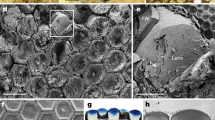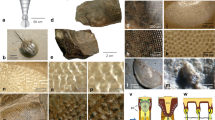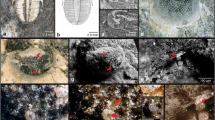Abstract
Until recently1, intricate details of the optical design of non-biomineralized arthropod eyes remained elusive in Cambrian Burgess-Shale-type deposits, despite exceptional preservation of soft-part anatomy in such Konservat-Lagerstätten2,3. The structure and development of ommatidia in arthropod compound eyes support a single origin some time before the latest common ancestor of crown-group arthropods4, but the appearance of compound eyes in the arthropod stem group has been poorly constrained in the absence of adequate fossils. Here we report 2–3-cm paired eyes from the early Cambrian (approximately 515 million years old) Emu Bay Shale of South Australia, assigned to the Cambrian apex predator Anomalocaris. Their preserved visual surfaces are composed of at least 16,000 hexagonally packed ommatidial lenses (in a single eye), rivalling the most acute compound eyes in modern arthropods. The specimens show two distinct taphonomic modes, preserved as iron oxide (after pyrite) and calcium phosphate, demonstrating that disparate styles of early diagenetic mineralization can replicate the same type of extracellular tissue (that is, cuticle) within a single Burgess-Shale-type deposit. These fossils also provide compelling evidence for the arthropod affinities of anomalocaridids, push the origin of compound eyes deeper down the arthropod stem lineage, and indicate that the compound eye evolved before such features as a hardened exoskeleton. The inferred acuity of the anomalocaridid eye is consistent with other evidence that these animals were highly mobile visual predators in the water column5,6. The existence of large, macrophagous nektonic predators possessing sharp vision—such as Anomalocaris—within the early Cambrian ecosystem probably helped to accelerate the escalatory ‘arms race’ that began over half a billion years ago7,8.
This is a preview of subscription content, access via your institution
Access options
Subscribe to this journal
Receive 51 print issues and online access
$199.00 per year
only $3.90 per issue
Buy this article
- Purchase on Springer Link
- Instant access to full article PDF
Prices may be subject to local taxes which are calculated during checkout



Similar content being viewed by others
References
Lee, M. S. Y. et al. Modern optics in exceptionally preserved eyes of Early Cambrian arthropods from Australia. Nature 474, 631–634 (2011)
Briggs, D. E. G., Erwin, D. H. & Collier, F. J. The Fossils of the Burgess Shale (Smithsonian Institution, 1994)
Hou, X.-G. et al. The Cambrian Fossils of Chengjiang, China: The Flowering of Early Animal Life (Blackwell, 2004)
Harzsch, S. & Hafner, G. Evolution of eye development in arthropods: phylogenetic aspects. Arthropod Struct. Dev. 35, 319–340 (2006)
Briggs, D. E. G. Giant predators from the Cambrian of China. Science 264, 1283–1284 (1994)
Vannier, J. & Chen, J.-. Early Cambrian food chain: new evidence from fossil aggregates in the Maotianshan Shale Biota, SW China. Palaios 20, 3–26 (2005)
Marshall, C. R. Explaining the Cambrian “explosion” of animals. Annu. Rev. Earth Planet. Sci. 34, 355–384 (2006)
Bush, A. M. & Bambach, R. K. Paleoecologic megatrends in marine Metazoa. Annu. Rev. Earth Planet. Sci. 39, 241–269 (2011)
Van Roy, P. & Briggs, D. E. G. A giant Ordovician anomalocaridid. Nature 473, 510–513 (2011)
Whittington, H. B. & Briggs, D. E. G. The largest Cambrian animal, Anomalocaris, Burgess Shale, British Columbia. Phil. Trans. R. Soc. Lond. B 309, 569–609 (1985)
Butterfield, N. J. Leanchoilia guts and the interpretation of three-dimensional structures in Burgess Shale-type fossils. Paleobiology 28, 155–171 (2002)
Nedin, C. Anomalocaris predation on nonmineralized and mineralized trilobites. Geology 27, 987–990 (1999)
Chen, J.-Y., Ramsköld, L. & Zhou, G.-Q. Evidence for monophyly and arthropod affinity of Cambrian giant predators. Science 264, 1304–1308 (1994)
Bergström, J. in Darwin’s Heritage Today. Proceedings of the Darwin 200 International Conference 29–42 (Higher Education, 2010)
Hou, X.-G., Bergström, J. & Ahlberg, P. Anomalocaris and other large animals in the Lower Cambrian Chengjiang fauna of southwest China. GFF 117, 163–183 (1995)
Usami, Y. Theoretical study on the body form and swimming pattern of Anomalocaris based on hydrodynamic simulation. J. Theor. Biol. 238, 11–17 (2006)
Collins, D. The “evolution” of Anomalocaris and its classification in the arthropod class Dinocarida (nov.) and order Radiodonta (nov.). J. Paleontol. 70, 280–293 (1996)
Daley, A. C., Budd, G. E., Caron, J.-B., Edgecombe, G. D. & Collins, D. The Burgess Shale anomalocaridid Hurdia and its significance for early euarthropod evolution. Science 323, 1597–1600 (2009)
Kühl, G., Briggs, D. E. G. & Rust, J. A great-appendage arthropod with a radial mouth from the Lower Devonian Hunsrück Slate, Germany. Science 323, 771–773 (2009)
Ma, X.-Y., Hou, X.-G. & Bergström, J. Morphology of Luolishania longicruris (Lower Cambrian, Chengjiang Lagerstätte, SW China) and the phylogenetic relationships within lobopodians. Arthropod Struct. Dev. 38, 271–291 (2009)
Gehling, J. G., Jago, J. B., Paterson, J. R., García-Bellido, D. C. & Edgecombe, G. D. The geological context of the lower Cambrian (series 2) Emu Bay Shale Lagerstätte and adjacent stratigraphic units, Kangaroo Island, South Australia. Aust. J. Earth Sci. 58, 243–257 (2011)
McKirdy, D. M. et al. Paleoredox status and thermal alteration of the lower Cambrian (Series 2) Emu Bay Shale Lagerstätte, South Australia. Aust. J. Earth Sci. 58, 259–272 (2011)
Gabbott, S. E., Hou, X.-G., Norry, M. J. & Siveter, D. J. Preservation of Early Cambrian animals of the Chengjiang biota. Geology 32, 901–904 (2004)
Gaines, R. R., Briggs, D. E. G. & Zhao, Y. Cambrian Burgess Shale-type deposits share a common mode of fossilization. Geology 36, 755–758 (2008)
Nedin, C. The Emu Bay Shale, a Lower Cambrian fossil Lagerstätten, Kangaroo Island, South Australia. Mem. Assoc. Austral. Palaeontol. 18, 31–40 (1995)
Cronin, T. W. & Porter, M. L. Exceptional variation on a common theme: the evolution of crustacean compound eyes. Evol. Edu. Outreach 1, 463–475 (2008)
Wehner, R. in Comparative Physiology and Evolution of Vision in Invertebrates: C 287–616 (Springer, 1981)
Harzsch, S. Neurophylogeny: architecture of the nervous system and a fresh view on arthropod phylogeny. Integr. Comp. Biol. 46, 162–194 (2006)
Vannier, J., García-Bellido, D. C., Hu, S.-X. & Chen, A.-L. Arthropod visual predators in the early pelagic ecosystem: evidence from the Burgess Shale and Chengjiang biotas. Proc. R. Soc. Lond. B 276, 2567–2574 (2009)
Hu, S.-X. et al. Diverse pelagic predators from the Chengjiang Lagerstätte and the establishment of modern-style pelagic ecosystems in the early Cambrian. Palaeogeogr. Palaeoclimatol. Palaeoecol. 254, 307–316 (2007)
Acknowledgements
We thank P. and C. Buck for access to and assistance at the fossil site; R. Atkinson, M. Gemmell, N. Schroeder, M. Binnie, J. Gehling, B. McHenry and others (Supplementary table 3 in ref. 1) for assistance with excavations and curation; A. Daley and J. Gehling for comments and advice; D. Birch and N. Vella for help with SEM-EDS analyses; and the Australian Research Council (grant LP0774959), South Australian Museum, University of Adelaide, MICINN-Spanish Ministry of Science (RYC2007-00090 and grant CGL2009-07073), Beach Energy and Sealink Pty Ltd for funding.
Author information
Authors and Affiliations
Contributions
All authors directly contributed to excavation and interpretation of fossil specimens, analysis, and writing the manuscript. J.R.P. and D.C.G.-B. conducted the digital photography and camera lucida drawings; G.A.B. and J.R.P. conducted the SEM-EDS analyses.
Corresponding author
Ethics declarations
Competing interests
The authors declare no competing financial interests.
Supplementary information
Supplementary Information
This file contains Supplementary Methods, Supplementary Figures 1-2 with legends, Supplementary Table 1 and additional references. (PDF 450 kb)
Rights and permissions
About this article
Cite this article
Paterson, J., García-Bellido, D., Lee, M. et al. Acute vision in the giant Cambrian predator Anomalocaris and the origin of compound eyes. Nature 480, 237–240 (2011). https://doi.org/10.1038/nature10689
Received:
Accepted:
Published:
Issue Date:
DOI: https://doi.org/10.1038/nature10689
This article is cited by
-
The median eyes of trilobites
Scientific Reports (2023)
-
Biomimetic apposition compound eye fabricated using microfluidic-assisted 3D printing
Nature Communications (2021)
-
Houcaris gen. nov. from the early Cambrian (Stage 3) Chengjiang Lagerstätte expanded the palaeogeographical distribution of tamisiocaridids (Panarthropoda: Radiodonta)
PalZ (2021)
-
Phylogenetic analysis and embryonic expression of panarthropod Dmrt genes
Frontiers in Zoology (2019)
-
First report of paired ventral endites in a hurdiid radiodont
Zoological Letters (2019)
Comments
By submitting a comment you agree to abide by our Terms and Community Guidelines. If you find something abusive or that does not comply with our terms or guidelines please flag it as inappropriate.



